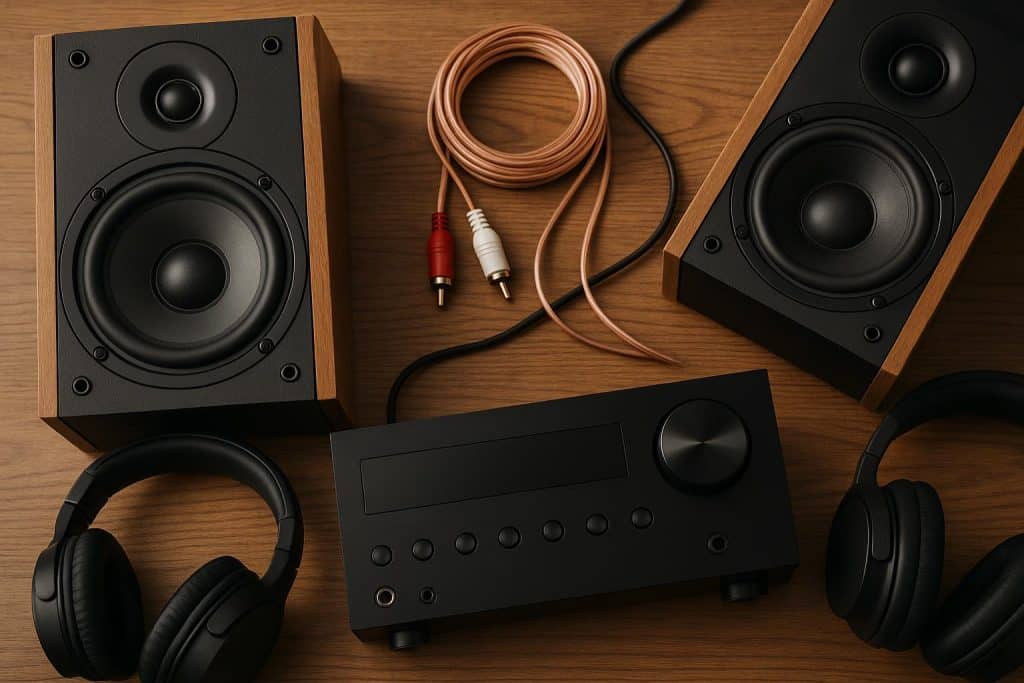Building a great home audio setup is about more than just buying high-end speakers or a powerful amplifier. It’s about creating a system where every component works in harmony to deliver rich, immersive sound that fits your space, preferences, and budget. Whether you’re setting up a dedicated home theater or simply upgrading your living room sound, the right tools and accessories make all the difference. Let’s explore how to choose the essential tools that can transform your home audio experience into something truly special.
1. Start with the Right Speakers
Speakers are the heart of any audio system, and choosing the right ones sets the tone for everything else. Consider your room size, listening habits, and the type of sound you prefer.
- Bookshelf speakers are ideal for small to medium rooms and deliver great clarity and detail.
- Floor-standing speakers offer deeper bass and a more powerful sound, making them perfect for larger spaces.
- Soundbars provide an all-in-one solution for minimal setups, especially in modern living rooms with limited space.
No matter which type you choose, ensure they complement your amplifier or receiver in terms of power and impedance for the best performance.
2. Pick a Reliable Amplifier or Receiver
An amplifier or AV receiver acts as the brain of your home audio system. It not only powers your speakers but also connects your media devices, such as TVs, gaming consoles, and streaming players. When selecting one, look for models that match your speaker’s power requirements and offer the right number of inputs for your devices.
Modern receivers often include built-in Bluetooth, Wi-Fi, and voice control compatibility, making it easier to stream music directly from your smartphone or smart assistant. If you’re building a home theater, consider a receiver that supports surround sound formats like Dolby Atmos or DTS:X for a cinematic experience.
3. Don’t Overlook Your Source Components
Your audio quality is only as good as the source feeding your speakers. Depending on your preferences, your system may include a turntable, CD player, media streamer, or even a digital audio player. Invest in components that support high-resolution audio to fully enjoy the clarity and depth of modern recordings.
For streaming enthusiasts, platforms like Spotify, Apple Music, and Tidal offer lossless audio options, but they truly shine when paired with a good digital-to-analog converter (DAC). A DAC ensures your digital files are converted to analog signals accurately, reducing distortion and preserving sound detail.
4. Use Quality Speaker Cables and Connectors
One of the most overlooked yet crucial elements in any audio setup is the cabling. High-quality speaker cables ensure that the signal from your amplifier reaches your speakers cleanly and without interference. It’s tempting to go cheap here, but low-grade cables can cause signal loss, resulting in flat or distorted sound.
When choosing speaker cables nz, look for oxygen-free copper (OFC) options with good insulation. These cables minimize resistance and maintain signal purity even over longer distances. The thickness of the cable (measured in gauge) also matters—thicker cables are better for longer runs or high-power systems. Additionally, using gold-plated connectors can improve conductivity and prevent corrosion over time. Investing in quality cables ensures that your system performs to its full potential and stays consistent for years to come.
5. Consider Acoustic Treatment
Even the best audio gear can sound subpar in a poorly treated room. Sound reflects off walls, floors, and ceilings, which can lead to echo or muffled tones. Acoustic panels, bass traps, and diffusers help absorb unwanted reflections and improve clarity.
If you’re setting up a home theater or music studio, positioning is key. Place your speakers at ear level and ensure they are equidistant from your main listening position. Rugs, curtains, and soft furnishings also help reduce harsh echoes in the room, creating a balanced, warm sound.
6. Get the Right Tools for Setup and Calibration
To fine-tune your system, you’ll need a few essential tools. A sound level meter or calibration microphone can help you balance speaker volumes, ensuring no single speaker overpowers the others. Many AV receivers come with built-in calibration software that automatically adjusts sound based on your room’s acoustics.
Additionally, using a speaker placement guide or laser measure can help achieve the perfect alignment and symmetry. The more precisely you position and calibrate your speakers, the more natural and immersive your audio experience will be.
7. Invest in Power Protection
Your audio equipment represents a significant investment, and it’s worth protecting. Voltage fluctuations or power surges can damage sensitive components. A good surge protector or power conditioner keeps your gear safe and can even improve sound performance by filtering electrical noise. Look for models with multiple outlets, especially if your setup includes several components like amplifiers, subwoofers, and streaming devices.
8. Keep It Organized
Cables and connections can quickly become a tangled mess if not managed properly. Use cable ties, clips, and labeling to keep everything neat and accessible. This not only makes maintenance easier but also prevents accidental disconnections or damage. A clean setup also looks more professional and can make a big difference in the overall aesthetic of your room.
9. Test and Adjust Regularly
Once your system is up and running, take time to test different types of audio—music, movies, podcasts, and games—to fine-tune your settings. Small adjustments to bass, treble, and balance can significantly improve your listening experience. Don’t be afraid to experiment; finding the perfect sound profile is a personal process.
Over time, as you upgrade equipment or rearrange your space, revisit your setup to ensure everything remains properly configured.

